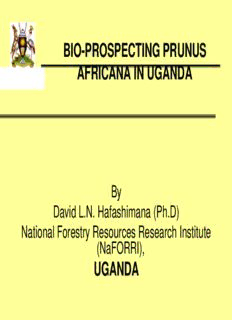
bio-prospecting prunus africana in uganda uganda PDF
Preview bio-prospecting prunus africana in uganda uganda
BIO-PROSPECTING PRUNUS AFRICANA IN UGANDA By David L.N. Hafashimana (Ph.D) National Forestry Resources Research Institute (NaFORRI), UGANDA Background • Bio-prospecting? Or Collaborative Research? • Prunus africana – African medicinal plant, widely distributed – wide variations genetically & chemically. • Commercial extraction & Export of bark a threat • Long term survival lies in successful plantations • Diverse plantations – higher chances of survival and market satisfaction Background … Project: DEVELOPMENT OF STRATEGIES FOR THE CONSERVATION AND SUSTAINABLE USE OF P. AFRICANA TO IMPROVE THE LIVELIHOODS OF SMALL-SCALE FARMERS Coverage: Some countries in Eastern, Central and Southern Africa (eg. Cameroon, South Africa, Uganda, Tanzania, Madagascar, Kenya, Tanzania etc) Partners involved Project objectives • Improve incomes and livelihoods of rural communities – improved germplasm • Support national and trans-boundary in- situ and ex-situ conservation strategies – establishment of gene reserves • Strengthen capacities of nationals for mgt of forest genetic resources Location of sample areas- Uganda Why the bother • Debarking taking place for bio-prospecting in different places, Africa-wide Why the bother … Chemical composition and Diversity of Prunus in 8 Uganda forests Forest Docosanol (mg/g of β-sistosterol (mg/g Mean diversity dry bark) of dry bark) estimate (H) Kibale 225 137 0.2021 Mt. Rwenzori 225 150 0.1206 Mt. Elgon 132 109 0.1757 Bwindi 129 124 0.1471 Bugoma 127 113 0.1670 Kasyoha- 125 101 0.1928 Kitomi Kalinzu 100 103 0.1967 Mabira 29 108 0.1881 Source: Malinga M. and Boffa, J.M. (2004). Assessment of bark quality and genetic diversity of Ugandan Prunus Africana populations for the development of on-farm cultivation and export markets. World Agroforestry Centre, Nairobi, Kenya and Forestry Resources Research Institute, Kampala, Uganda. (Unpublished report). Highlights of the MTA • Type of Agreement - Material Transfer Agreement – (in line with Ugandan law) • Type and quantity of resource(s) - Prunus africana bark (for Chemical analysis) and leaves (for genetic analysis); Small quantities for research/ analysis – (In Austria) • Purpose of collection and expected results – Research; results to be returned for use in mother garden (Gene reserves) establishment Highlights … • Location of research and development • a)Partly in Provider country (collection, multiplication and scaling out/ planting) and b) Partly in User country (Chemical and genetic analysis – samples from different participating countries)
Description: